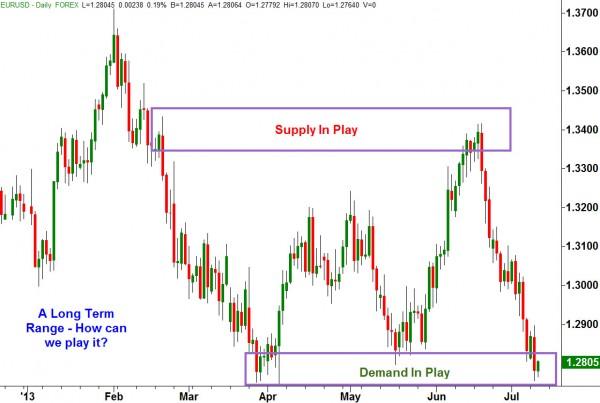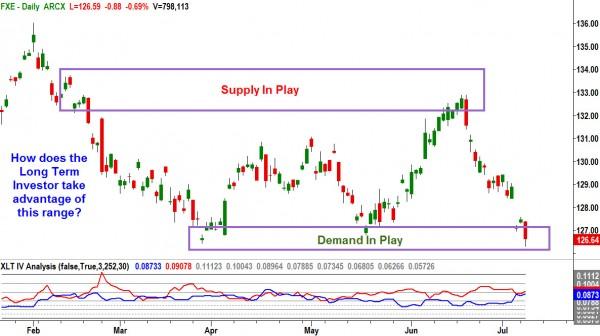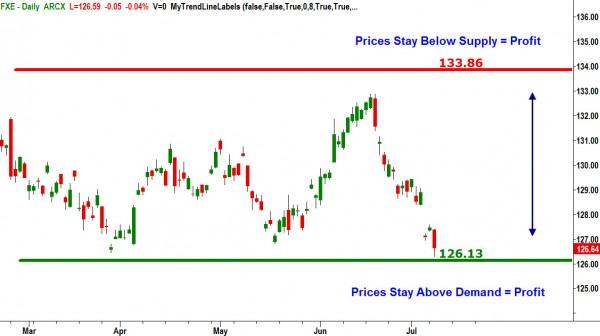![]()
Continuing on from my last article, I want to expand upon how we can effectively use options in the worldwide currency markets. As I explained in my previous article, I’m a big fan of the options market and it was always my intention to become a full-time options trader. However understanding price action, how to time the market and how institutions behave on a daily basis when they are buying and selling, is paramount to successful trading. Without a thorough understanding of how the market really works, there is absolutely no point in starting to trade options. Many novice traders start out trading stocks and then they move into options because they want more leverage, only to find out that they lose their money a whole lot quicker. These guidelines were taught to me when I was a student and I have made it my job to make sure that my students today are aware of the dangers and also the benefits of options, only obtained if you are fully aware of the rules and the mechanics that go with them.
Now I know some of you are reading this article and are thinking to yourselves, “Why is this guy writing about options? Isn’t this meant to be a Forex article?” Well you are correct but I wanted to show all of the readers of my articles that while FX is a wonderful market to trade and is beneficial for both day trading, medium term swing trading and even position trading to some degree, there are alternative ways to approach the currency markets, and we need to be aware of these and what better way than the option markets? Let’s face it, not everybody wants to be an active trader every single day or even placing trades every single week. Some currency traders and long-term investors want to have a more relaxed approach to the market and options offer that approach, if you know what you are looking for.
So the question is what can we do to take a long term approach to the currency markets, with a methodology that would benefit position and investing styles of approaching the markets and also generate both a short time income and/or a long time wealth solution? The answer lies in looking at the right asset class product to trade and picking the correct strategy that suits a hands-off approach to currency trading. Let’s take a look at a daily chart of EURUSD, so we can find out when this type of strategy would be appropriate to use:
Notice that I have selected the daily chart. I would encourage any longer term traders/investors or for that matter anybody who wants to have a more relaxed approach to the market, to focus on the larger timeframe charts, as this gives us more time to do our analysis, to plan our trades, thus allowing us to truly set and forget our positions. As we can see from this chart, the long-term outlook on the daily picture shows us that the Euro has been trading between a major level of demand and a major level of supply, going up and down in a wide range. Of course, the market could break down lower or higher when it next tests these major levels, however until that happens I want to play the range and be a buyer at institutional demand and a seller at institutional supply.
The one disadvantage I do have though, is that to make any decent profits, is that I need the market to move in my direction. By substituting the spot currency pair for something like the FXE ETF equivalent, we can make the use of options, allowing us to not have to rely on direction to give us a profit. The FXE ETF trades like a stock, however it mimics the Euro versus the US dollar currency pair, making it the ideal product to trade if I want to make use of options. Let’s switch over to a daily chart of the FXE:
Here we can see an example of the FXE ETF chart. Yes it does have gaps, as it only trades during the open New York market hours, however it tracks the spot currency perfectly and is the ideal substitute for the currency pair so we can play our options on this market. The only extra factor which we have to be concerned about is volatility. Notice there is a graph underneath the chart of FXE which shows the volatility gauge. Options traders need to be aware of the added dimension of volatility when they place their trades. If we ignore volatility and its impact on the value of options, we’re falling into a deadly trap. Therefore we need to be aware that it is necessary to combine both market timing with supply and demand and our understanding of volatility and its effect on premiums, when we buy and sell options.
Many novice traders fail in their options speculation because they are not aware of how important it is to both time the market and be aware of implied volatility. While options are a complicated asset class to master, our classroom and XLT programs give our students a thorough understanding of how these markets work. A simple rule which I can share with you right now is that we never want to pay high premiums for options. This is the best time to sell options and will be a vital component of our long term currency strategy plays. However, when you do have a solid understanding of how to position yourself in the correct manner, options allow a generous advantage which is not available in outright trading positions.
Notice our volatility indicator in the FXE chart above. This tells us that there is fear in the market place and so options are commanding higher premiums. This is just like any other insurance policy: The higher the perceived risk, the higher the premium. This gives us the opportunity to sell “insurance” against the Euro rising or falling above or below a pre-determined price level. By selling these options, we are paid a premium or credit, which we get to keep if prices do not breach their predefined levels. Take a look at the chart below:
As a disciplined market speculator and assuming that price will stay above our current demand area at 126.13, I can take out an options play called a Bull Put spread. By selling these options, I will instantly be paid. All that has to happen is that prices have to stay above 126.13 for me to remain in profit and the options which I sold expire worthless when time value has run out.
Likewise should the price of the FXE be up at 133.86 I can take out the options play called a Bear Call spread. I can sell somebody else the right to be long on the market above my entry price however if the FXE stays below 133.86, I get to keep the credit which I received upon selling the options or the time value will eventually run out and the option will expire worthless in the hands of the person who bought it from me. Both options strategies have the advantage in that they do not rely on the market having to go up or down for me to make a profit. This is the only way we can trade in the markets without having to rely on direction, thus making them the ideal tool for the hands-off, long-term proactive investor.
Of course there are many more details to what I have highlighted in this article. By no means do I expect that I can explain exactly how these option strategies work in just a few pages of this piece. However I wanted to give you all a very solid understanding of the possibilities of options and how they work with currencies and different market conditions. Our students at Online Training Academy understand our core strategy and how to time the markets, giving them a solution for short term income and long-term wealth across the board. If you would like to find out more about how our ProActive Investing Course works with currencies contact your local campus. I hope you enjoyed this article.
Have a great trading week.
Note: All information on this page is subject to change. The use of this website constitutes acceptance of our user agreement. Please read our privacy policy and legal disclaimer. Opinions expressed at FXstreet.com are those of the individual authors and do not necessarily represent the opinion of FXstreet.com or its management. Risk Disclosure: Trading foreign exchange on margin carries a high level of risk, and may not be suitable for all investors. The high degree of leverage can work against you as well as for you. Before deciding to invest in foreign exchange you should carefully consider your investment objectives, level of experience, and risk appetite. The possibility exists that you could sustain a loss of some or all of your initial investment and therefore you should not invest money that you cannot afford to lose. You should be aware of all the risks associated with foreign exchange trading, and seek advice from an independent financial advisor if you have any doubts.
Editors’ Picks
AUD/USD stands firm above 0.6500 with markets bracing for Aussie PPI, US inflation

The Aussie Dollar begins Friday’s Asian session on the right foot against the Greenback after posting gains of 0.33% on Thursday. The AUD/USD advance was sponsored by a United States report showing the economy is growing below estimates while inflation picked up. The pair traded at 0.6518.
EUR/USD faces a minor resistance near at 1.0750

EUR/USD quickly left behind Wednesday’s small downtick and resumed its uptrend north of 1.0700 the figure, always on the back of the persistent sell-off in the US Dollar ahead of key PCE data on Friday.
Gold soars as US economic woes and inflation fears grip investors

Gold prices advanced modestly during Thursday’s North American session, gaining more than 0.5% following the release of crucial economic data from the United States. GDP figures for the first quarter of 2024 missed estimates, increasing speculation that the US Fed could lower borrowing costs.
Bitcoin price continues to get rejected from $65K resistance as SEC delays decision on spot BTC ETF options

Bitcoin (BTC) price has markets in disarray, provoking a broader market crash as it slumped to the $62,000 range on Thursday. Meanwhile, reverberations from spot BTC exchange-traded funds (ETFs) continue to influence the market.
US economy: Slower growth with stronger inflation

The dollar strengthened, and stocks fell after statistical data from the US. The focus was on the preliminary estimate of GDP for the first quarter. Annualised quarterly growth came in at just 1.6%, down from the 2.5% and 3.4% previously forecast.
RECOMMENDED LESSONS
Making money in forex is easy if you know how the bankers trade!
Discover how to make money in forex is easy if you know how the bankers trade!
5 Forex News Events You Need To Know
In the fast moving world of currency markets, it is extremely important for new traders to know the list of important forex news...
Top 10 Chart Patterns Every Trader Should Know
Chart patterns are one of the most effective trading tools for a trader. They are pure price-action, and form on the basis of underlying buying and...
7 Ways to Avoid Forex Scams
The forex industry is recently seeing more and more scams. Here are 7 ways to avoid losing your money in such scams: Forex scams are becoming frequent. Michael Greenberg reports on luxurious expenses, including a submarine bought from the money taken from forex traders. Here’s another report of a forex fraud. So, how can we avoid falling in such forex scams?
What Are the 10 Fatal Mistakes Traders Make
Trading is exciting. Trading is hard. Trading is extremely hard. Some say that it takes more than 10,000 hours to master. Others believe that trading is the way to quick riches. They might be both wrong. What is important to know that no matter how experienced you are, mistakes will be part of the trading process.




